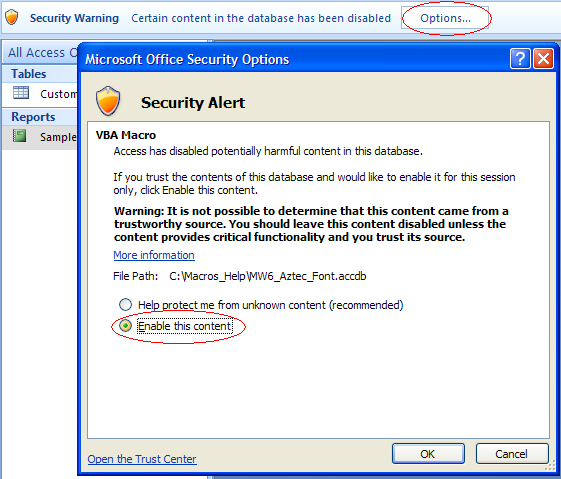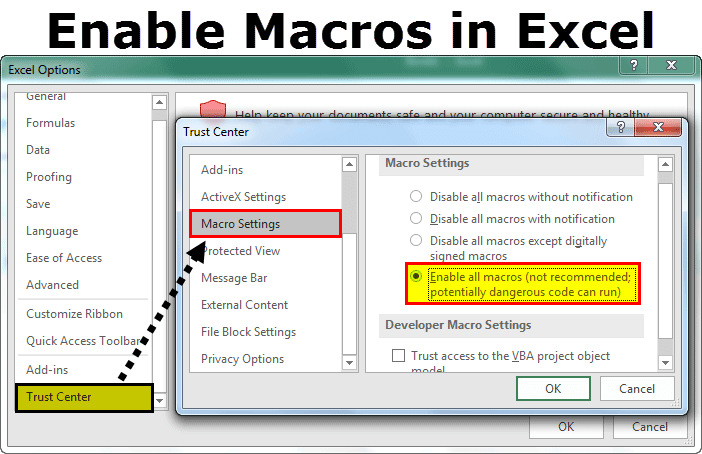
- ENABLE MACROS IN ACCESS RUNTIME 2010 HOW TO
- ENABLE MACROS IN ACCESS RUNTIME 2010 INSTALL
- ENABLE MACROS IN ACCESS RUNTIME 2010 FULL
- ENABLE MACROS IN ACCESS RUNTIME 2010 CODE
- ENABLE MACROS IN ACCESS RUNTIME 2010 PASSWORD
My problem is that the script works find until right after the first DB is closed, then I get an error saying:ĪctiveX component can't create object: "Access.Application".
ENABLE MACROS IN ACCESS RUNTIME 2010 PASSWORD
the second DB it's password protected and I want to have it open without asking the user for the password (this should be passed from the command line).once the user will be authenticated a macro behind the log in button will pass the execution to an external file (at this time I'm using a vbs) that it willĬlose the current DB and should open the next DB. open the first DB which is a log in form that is connected to a SP.Not multiple users sharing the same Front-End.I created two DB's in Access 2010 that I will deploy to other PC that will not have Office 2010 installed or will not have it at all, therefore I'm using Access 2010 runtime to enable them to use my DB's. Is that each user uses his/her own copy of the Front-End, Not sure what you mean by "appdata" level but if you mean each user uses a separate copy of the Front-End in the user's own "Documents & Settings" (or whatever the equivalent in Windows 2012 Server) then it is fine.
ENABLE MACROS IN ACCESS RUNTIME 2010 INSTALL
I got a tip from another member here that pointed me in that direction.>As for the multi-user aspect on the remote desktop virtual server the customer doesn't want to pay for multiple virtual machines.>So I'm thinking I would configure the package to install at the user appdata level.<<

>My SP3 runtime version did not show on the server.
ENABLE MACROS IN ACCESS RUNTIME 2010 CODE
For example, I use LineNumber in my code and my error trappingĪt least gives me the ErrorNo, ErroDesc and the LineNo where the error occurs. In addition (depending on how much effort you want to put in), error-trapping code can give you detailed info. If you are using run-time version, it is critical that you have error-trapping code to handle the run-time errors in every procedure since if any unhandled error occurs, your database using Access run-time >Another question: Do you know if each user that opens the server based app will have a separate environment they run in to deal with frontend tables without stepping on each other?>I'm not seeing any helpful error codes or messages.<< change the name of this DWORD to "AllowSubfolders" and right click and modify. to include subdirectories as trusted locations, add a DWORD by right clicking the new key, selecting New > DWORD (32-bit) Value ġ1. the Value Data to the path or network name required (ie "Z:\" or "\\servername" ) ġ0.

Change the name of this file to "Path" and then right-click and modify. Right click the new Key and select New > Expandable String Value (for runtime 2013, just String Value for earlier version) ĩ. now add a new KEY to the Trusted Locations directory by right clicking the directory and selecting New > Key (You can rename this to something meaningful) Ĩ.

change the name of the DWORD to "AllowNetworkLocations" Ħ. add a DWORD by right clicking the Trusted Locations directory, selecting New > DWORD (32-bit) Value ĥ. navigate to HKEY_CURRENT_USER\Software\Microsoft\Office\15.0\Access\Security\Trusted Locations Ĥ. allow Microsoft Windows Registry Editor to make changes to your system ģ. use the search in Win 7 or Win 8 and type in "regedit.exe" Ģ. To enable trusted locations on a network drive (note items in "" are values entered - do not include the "):ġ. I did finally figure this out and post the answer here for anyone with the same issue in the future. I tried both REG_SZ and REG_EXPAND_SZ for the Path = Z:\, but I still get the warning. HKEY_CURRENT_USER\Software\Microsoft\Office\15.0\Access\Security\Trusted Locations\Location(0)
ENABLE MACROS IN ACCESS RUNTIME 2010 HOW TO
I do know how to set up the registry by adding keys: Clearly something is missing but I can't figure out what it is. (say C:\Temp) drive, but disappears once the registry is changed, so this does work - just not on a mapped network drive.

Strangely it does work for local drives: The warning appears if the.
ENABLE MACROS IN ACCESS RUNTIME 2010 FULL
However, in access 2013 runtime, this does not seem to work, although it does work on the full version. The Path =Z:\ and the warning would disappear. In access 2010 you could play with the registry items (which seems bush league, but this is for another blog.) and set Every time I run the app I get a MS Access Security warning message stating that this is not a trusted location. The individual PCs only have access 2013 runtime, not the full version, and in fact they do not have office 2013 at all, only officeĢ010. accde application that is located on a network drive mapped to individual PCs (say Z:\).


 0 kommentar(er)
0 kommentar(er)
